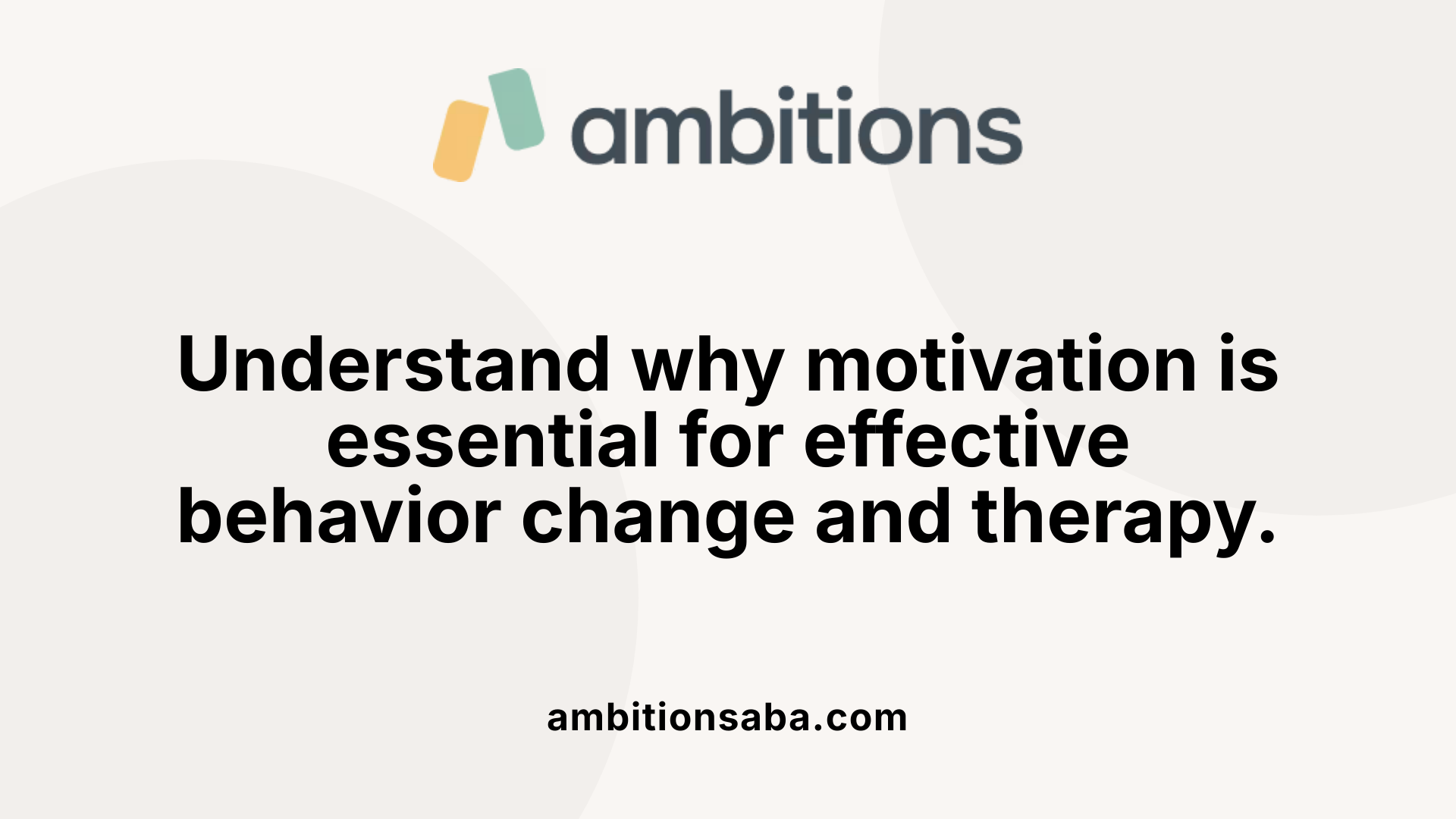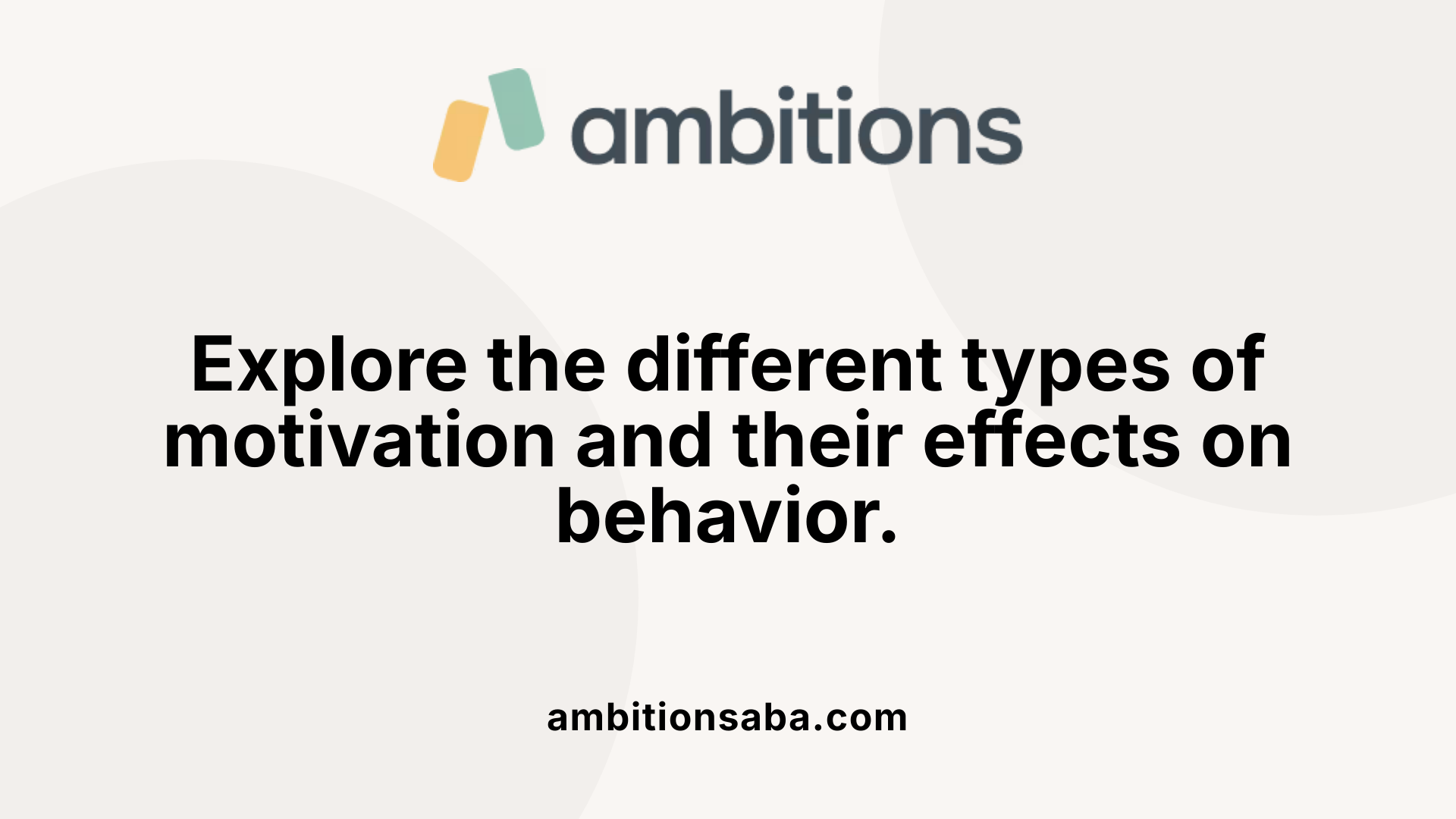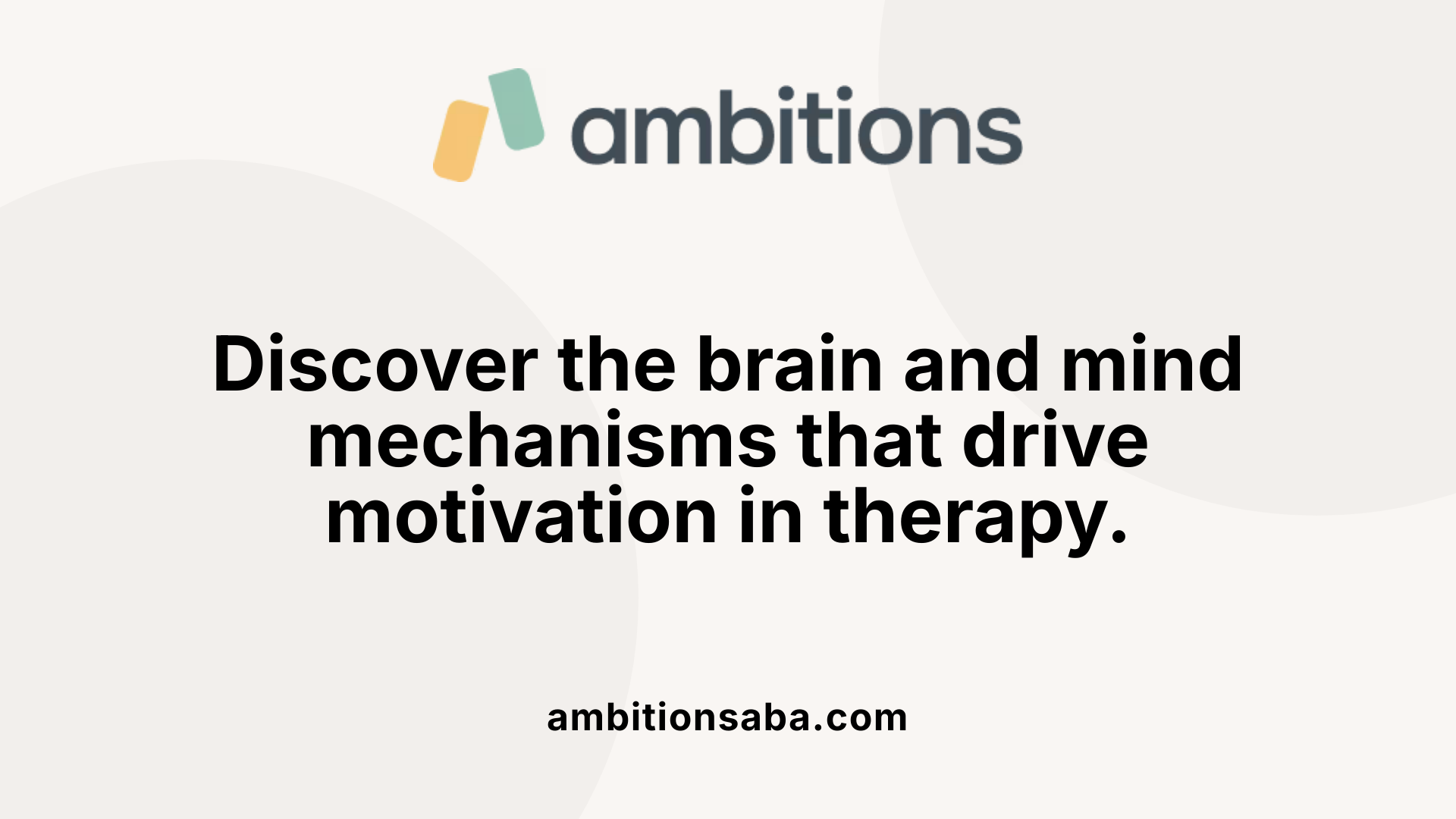Understanding Motivation's Role in Behavior Change and Therapy
Motivation serves as the fundamental engine driving human behavior, especially in clinical settings such as behavior therapy. Recognizing what motivates individuals—and how this motivation influences their capacity to adopt and maintain new behaviors—is crucial for effective intervention. This article explores the multifaceted nature of motivation, its underlying theories and mechanisms, neurobiological and psychological aspects, and practical strategies to harness it for successful therapy outcomes.
Defining Motivation and Its Influence on Behavior
What is motivation and how does it influence behavior?
Motivation is the driving force behind human actions and behaviors. It encompasses both internal desires and external influences that propel individuals to start, continue, and persevere in goal-related activities. Essentially, motivation energizes behavior in pursuit of specific objectives, whether they are personal, professional, or social.
This psychological process impacts every aspect of life, from daily routines to long-term achievements. When motivated, people tend to put in more effort, stay committed despite obstacles, and achieve higher levels of performance. Conversely, a lack of motivation can result in procrastination, apathy, and poorer outcomes.
Theories like Maslow’s Hierarchy of Needs and Self-Determination Theory shed light on how motivation operates. Maslow’s model suggests that fulfilling foundational needs such as safety and physiological requirements paves the way toward self-actualization, which is driven by intrinsic motivation. Self-Determination Theory emphasizes the importance of autonomy, competence, and relatedness—these needs foster internal motivation for sustained engagement.
Various factors influence motivation, including personal values and beliefs, self-efficacy, social support, and past experiences. Emotions also play a significant role; positive feelings can boost motivation, while negative emotions may diminish it.
Strategies to enhance motivation involve establishing clear, achievable goals, providing recognition and rewards, fostering supportive environments, and encouraging autonomy. Techniques such as goal setting, positive reinforcement, and constructive feedback can help individuals reinforce their motivation.
Understanding motivation is essential across many fields—education, therapy, workplace management, and health promotion. It guides the development of strategies to increase engagement, improve perseverance, and nurture resilience. Ultimately, motivation turns aspirations into actions, creating a pathway toward personal growth and well-being.
Motivation’s Critical Role in Behavior Change and Therapeutic Success

Why is motivation important in behavior change and therapy?
Motivation plays a pivotal role in facilitating and sustaining behavioral changes, particularly within therapeutic settings. It acts as the energizing force that drives individuals to initiate and persist with new behaviors, which is essential for long-term success.
In therapy, motivated clients are more likely to engage actively with treatment plans, adhere to prescribed activities, and overcome obstacles that may otherwise impede progress. Motivation influences not just the willingness to start a change but also its maintenance over time.
The importance of motivation is rooted in its ability to sway a person's readiness across different stages of change. According to models like the Transtheoretical Model, motivation facilitates movement from contemplation to action and eventually to maintenance, ensuring that behavior change is more than just a temporary effort.
Internal factors significantly shape motivation. Personal beliefs, levels of self-efficacy, values, and past experiences can either encourage or hinder behavioral efforts. For example, a person with high self-confidence and clear personal goals will typically find it easier to stay motivated than someone facing doubts or negative past experiences.
Effective strategies to bolster motivation include motivational interviewing, which helps resolve ambivalence and strengthen commitment, and goal setting, which provides clarity and tangible targets. These approaches address both intrinsic motivation—driven by personal satisfaction—and extrinsic motivation—fueled by external rewards or recognition.
By fostering motivation, therapists can empower clients to take an active role in their change process. This active participation often results in better treatment adherence, more positive outcomes, and more enduring changes. Essentially, motivation acts as the engine that propels individuals through the often challenging process of behavior modification, making it a cornerstone of successful therapy and personal growth.
Types of Motivation in Psychology and Their Impact

What are the different types of motivation in psychology?
In psychology, motivation is generally divided into two main categories: intrinsic and extrinsic motivation. Each type plays a vital role in influencing how individuals behave and pursue their goals.
Intrinsic motivation is driven by internal factors. When someone is intrinsically motivated, they engage in activities because they find them interesting, enjoyable, or personally meaningful. For example, a student who reads a book for pleasure or a musician practicing simply for personal satisfaction is acting based on intrinsic motivation. This form of motivation encourages genuine engagement, creativity, and a sense of personal fulfillment.
Extrinsic motivation, on the other hand, is influenced by external rewards or pressures. People motivated extrinsically perform tasks to obtain benefits such as money, recognition, or social approval. For instance, studying to earn good grades or working to receive a bonus reflect extrinsic motivation. While it can effectively initiate behavior, extrinsic motivation often depends on external factors that may fluctuate over time.
Both motivation types can coexist, influencing behavior to varying degrees based on individual circumstances. Theories like Self-Determination Theory suggest that motivation is stronger and more sustainable when individuals perceive their actions as autonomous and aligned with their personal values.
Understanding the distinction between intrinsic and extrinsic motivation is essential for designing strategies in education, work, and therapy. Harnessing intrinsic motivation tends to lead to more enduring and meaningful engagement, whereas extrinsic rewards can be effective for initial behavior change but may require reinforcement to sustain long-term motivation.
In summary, knowing which type of motivation is at play can help optimize approaches to goal setting, learning, and personal growth by fostering environments that promote autonomy, competence, and relatedness, ultimately leading to better outcomes in various aspects of life.
Theories and Mechanisms Underpinning Motivation in Therapy
What are the theories and mechanisms behind motivation in therapy?
Motivation in therapy is rooted in a range of psychological and biological models that explain what drives individuals to initiate and maintain changes in behavior. Among the most influential psychological frameworks is Self-Determination Theory (SDT), which emphasizes the importance of fulfilling three basic psychological needs: autonomy, competence, and relatedness. When these needs are supported, individuals tend to experience increased intrinsic motivation, leading to more sustainable and meaningful behavior change.
Maslow’s Hierarchy of Needs is another foundational theory that describes a progression from basic physiological needs to self-actualization. According to Maslow, motivation moves up through different levels, ultimately reaching the need for personal growth and fulfillment, which is often the goal of therapeutic interventions.
On a biological level, motivation involves complex brain mechanisms. Central to these are neural circuits involving the neurotransmitter dopamine, particularly within the mesolimbic pathway. This dopamine system plays a key role in reinforcement learning, reward processing, and evaluating the salience of stimuli, which collectively influence motivation's activation, persistence, and vigor.
These neural mechanisms operate through interconnected circuits that respond to both intrinsic rewards, like personal satisfaction, and extrinsic incentives, such as recognition or rewards. For example, activities that produce feelings of competence and success can stimulate dopamine release, reinforcing continued effort.
Moreover, motivation in therapy is not solely driven by internal factors; external influences—like rewards, recognition, or social support—interact within neural and emotional systems to motivate behavior. This dual influence ensures a complex, dynamic neural landscape supporting goal-directed actions.
In clinical practice, understanding these theories and mechanisms allows therapists to develop strategies that reinforce motivation. Techniques such as fostering autonomy, setting achievable goals, and providing meaningful feedback tap into these psychological needs and neural responses. By addressing both the mind and brain’s contributions to motivation, interventions can be tailored to overcome motivational deficits, enhance effort, and promote long-term positive change.
Neurobiological and Psychological Foundations of Motivation in Behavior Therapy

How do neurobiological and psychological aspects relate to motivation in behavior therapy?
Motivation is driven by complex interactions within the brain, involving specific regions that process reward, decision-making, and emotional responses. Key areas include the ventral tegmental area, nucleus accumbens, prefrontal cortex, amygdala, and hippocampus. These regions communicate through dopamine signaling, which acts like a reward courier, reinforcing behaviors that lead to positive outcomes.
Dopamine plays a vital role by encoding reward predictions, strengthening memories related to positive experiences, and supporting reinforcement learning. When we anticipate a reward or experience pleasure, dopamine release encourages us to repeat behaviors, fostering motivation to pursue goals.
Psychologically, motivation also depends on personal beliefs, emotions, and cognitive strategies. For instance, having clear goals, self-efficacy (belief in one's abilities), and positive emotional states can enhance motivation. Conversely, negative feelings or low self-esteem can diminish it.
Environmental cues and social support significantly influence both neurobiological and psychological components. Supportive environments can activate reward pathways and boost confidence, while adverse conditions may dampen motivation.
Together, these neurobiological and psychological facets operate dynamically. In behavior therapy, understanding this relationship helps tailor interventions that target both brain mechanisms and cognitive-behavioral strategies. Techniques like motivational interviewing or reinforcement can enhance neural reward responses while addressing internal beliefs and emotional barriers.
For example, by combining mindfulness to reduce negative emotions and goal-setting to foster intrinsic motivation, therapists can optimize the interaction between brain function and personal motivation strategies. Recognizing how these elements influence one another provides a comprehensive approach to fostering sustained behavioral change.
Strategies to Enhance Motivation in Clinical Practice

What strategies can be used to enhance motivation in therapy?
Enhancing motivation within clinical settings involves a mix of practical techniques aimed at fostering engagement and persistence. One effective approach is setting clear and achievable goals. When clients understand what they are working towards and see that progress is possible, their motivation tends to increase.
Motivational interviewing is another powerful tool. This client-centered technique helps resolve ambivalence, encouraging clients to identify personal reasons for change. It emphasizes collaboration rather than persuasion, making clients feel supported rather than pressured.
Creating supportive environments also plays a crucial role. When the surroundings reinforce positive behaviors through encouragement, validation, and understanding, individuals feel more motivated to stay committed.
Besides these, other strategies include enhancing self-efficacy — helping clients believe in their capacity to succeed, which boosts their motivation to act. Celebrating small victories along the way can reinforce positive effort and build momentum.
In practice, combining these methods can significantly improve therapy outcomes. Establishing a collaborative relationship, aligning therapy goals with the client’s personal values, and making activities relevant and enjoyable all contribute to sustaining motivation. This integrated approach helps clients stay engaged and committed to their behavioral change journey.
Why are these strategies effective?
These techniques address both internal factors—like confidence and personal relevance—and external factors, such as the environment and social support. When clients feel competent, autonomous, and supported, they are more likely to maintain their efforts over time.
Overall, adopting these strategies in clinical practice can lead to more resilient motivation, better adherence to treatment plans, and ultimately, more successful behavioral change outcomes.
| Technique | Purpose | Benefits |
|---|---|---|
| Goal setting | Clarifies objectives and increases commitment | Enhances focus and motivation |
| Motivational interviewing | Resolves ambivalence, increases readiness to change | Strengthens intrinsic motivation |
| Supportive environments | Creates a positive context for change | Sustains effort and reduces resistance |
| Self-efficacy enhancement | Builds confidence in ability | Promotes persistence |
| Celebrating progress | Reinforces effort and success | Maintains engagement |
Understanding and applying these methods can considerably improve clinical outcomes by actively engaging clients in their own change process.
The Interplay of Emotions, Needs, and External Influences in Motivation
How do neurobiological and psychological aspects relate to motivation in behavior therapy?
Motivation is fundamentally driven by both neurobiological and psychological processes. Neurobiologically, key brain regions such as the ventral tegmental area, nucleus accumbens, prefrontal cortex, amygdala, and hippocampus are deeply involved in motivation. These areas communicate through dopamine signaling within the brain’s reward pathways, which reinforces behaviors that are perceived as rewarding and facilitates goal-oriented actions.
Dopamine acts as a messenger that encodes reward prediction, meaning it helps the brain anticipate and learn from rewarding outcomes. This process strengthens reward-related memories and supports reinforcement learning, which in turn increases motivation to repeat behaviors that lead to positive results. In other words, the brain’s reward system acts as a biological engine that energizes pursuit of goals.
Psychological factors form a vital counterpart to these neural mechanisms. Personal beliefs, emotional conditions, cognitive appraisals, and goal-setting strategies influence ongoing motivation. For example, a person’s sense of self-efficacy—belief in their ability to succeed—can enhance motivation, while negative emotions or doubts can diminish it.
Environmental cues and social support further shape motivational levels by providing external stimuli and reinforcement. Supportive environments and relationships can boost confidence and sustain effort, whereas negative social influences can undermine motivation.
In behavior therapy, understanding this combined influence is essential. Therapists often aim to modify psychological factors—such as beliefs, emotional states, and motivations—while also considering neurobiological responses. Interventions may include strategies to enhance positive emotions, build self-efficacy, establish clear goals, and create supportive environments.
The dynamic interaction between neurobiological and psychological aspects of motivation illustrates that motivating behavior involves a complex network of internal brain processes and external influences. Recognizing this interplay helps tailor more effective therapeutic approaches that address both the mind and brain to foster lasting behavioral change.
Additional Information
Searching for "neurobiological and psychological aspects of motivation in therapy" provides further insights into how these factors are applied in clinical settings. Understanding these interactions supports the development of strategies that optimize motivation, crucial for sustained behavior change and mental health improvement.
Impairments and Disorders Related to Motivation
What disorders are associated with motivation deficits or excesses?
Motivational challenges are prominent in various mental health conditions. Schizophrenia and affective disorders, such as depression and bipolar disorder, often feature significant motivational deficits. These conditions disrupt the neural circuits responsible for initiating and sustaining goal-directed behavior. Individuals with schizophrenia, for example, commonly experience apathy and anhedonia — a lack of pleasure — which diminish their engagement in daily activities and treatment. Such deficits stem from disruptions in dopamine pathways and other neurochemical systems that regulate motivation.
On the other hand, excessive motivational behaviors are seen in addiction. Addicts often pursue rewards compulsively, despite facing adverse consequences. This hyperactive pursuit of pleasure indicates a dysfunction in the brain's reward circuitry, especially within the mesolimbic dopamine system. These patterns can lead to maladaptive behaviors that interfere with personal and social functioning.
Effective treatments for these motivational disturbances include behavioral therapies, which help reshape behaviors and cognition. Pharmacological approaches, such as antidepressants and antipsychotics, target underlying neurochemical imbalances. Moreover, advanced neural modulation techniques like deep brain stimulation (DBS) and transcranial magnetic stimulation (TMS) are increasingly used to adjust dysfunctional neural circuits.
Understanding and addressing motivation-related disorders is crucial for improving therapeutic outcomes and restoring individuals' capacity to engage meaningfully in life. Advances in neuroscientific research continue to illuminate how neural, molecular, and behavioral factors interplay in these conditions, paving the way for more personalized and effective interventions.
Motivation's Impact on Learning, Health, and Personal Growth
How does motivation facilitate learning, mental health, and behavior modification?
Motivation serves as a driving force behind human actions, directly influencing people's willingness and persistence in engaging with activities that promote learning, health, and personal growth. It energizes individuals to initiate tasks, maintain effort despite obstacles, and perform with focus and vigor.
In educational settings, motivation—particularly intrinsic motivation—enhances engagement and deepens understanding. When students are genuinely interested or find personal satisfaction in learning, they tend to retain information better and persist longer in challenging tasks. Strategies such as setting clear goals, making learning relevant, and fostering autonomy help cultivate intrinsic motivation, leading to improved academic outcomes.
Mental health is closely tied to motivation. Positive motivation contributes to resilience, emotional well-being, and the capacity to cope with stress. When individuals perceive they can succeed and experience fulfillment, their motivation increases, promoting a cycle of positive emotional states and behaviors. Conversely, low motivation often correlates with mental health issues like depression or anxiety, which can create a barrier to engaging in beneficial activities.
Behavior modification is more effective when motivation is high. For instance, in health behaviors, motivated individuals are more likely to stick to exercise routines, adhere to medication schedules, and adopt healthier lifestyles. Supportive environments and targeted techniques—like motivational interviewing—can enhance intrinsic motivation, making behavioral changes more sustainable.
Moreover, understanding and leveraging motivation can foster long-term personal development. When people are motivated, they tend to pursue goals aligned with their values, leading to a sense of control and mastery. This not only improves their overall well-being but also encourages ongoing growth, resilience, and life satisfaction.
Overall, motivation acts as a psychological engine that influences effort, persistence, and emotional responses. By nurturing motivation through strategies that boost perceived competence, autonomy, and relevance, individuals can achieve meaningful progress in learning, health, and personal endeavors.
Integrating Motivation Strategies into Behavior Therapy Practice
What are effective strategies to embed motivation into therapy?
To foster lasting behavior change, clinicians can adopt a variety of approaches that actively enhance a client’s motivation. Personalized goal setting is a foundational step, where goals are tailored to align with the individual’s values, interests, and current abilities. This approach not only increases relevance but also boosts intrinsic motivation, making the activity more engaging and meaningful.
Contextualizing activities to reflect the client's personal interests and environmental realities can significantly heighten motivation. When tasks resonate with an individual's passions or life goals, they are more likely to participate actively and persist through challenges.
Providing immediate and meaningful reinforcement is another vital component. Celebrating small successes and offering positive feedback helps build self-efficacy, fostering confidence in the client’s ability to sustain changes.
Fostering autonomy involves empowering clients to make choices about their behaviors, thereby enhancing their intrinsic motivation. When individuals feel in control of their actions, they are more motivated to initiate and maintain change.
Creating a positive and supportive environment is essential. This includes building a strong therapeutic alliance, where clients feel understood, respected, and encouraged. Techniques like motivational interviewing serve to explore ambivalence, enhance motivation, and facilitate readiness for change. By asking open-ended questions, expressing empathy, and reinforcing personal strengths, therapists help clients articulate their reasons for change.
Effective strategies also involve providing constructive feedback that highlights clients’ progress and capabilities. This reinforces perceived competence, which is closely linked to motivation.
In summary, integrating these strategies—personalized goals, contextual relevance, reinforcement, autonomy support, and empathetic communication—can make behavior therapy more effective. The goal is to empower individuals, build confidence, and ensure that behavioral changes are both meaningful and sustainable over the long term.
How can these concepts be practically applied?
Therapists should tailor interventions to each client, ensuring that activities are relevant and sufficiently challenging, yet realistic. Incorporating motivational interviewing techniques can uncover and resolve ambivalence towards change. Continual monitoring of progress, combined with positive reinforcement, sustains motivation. Ultimately, by making the process engaging and client-centered, practitioners can significantly improve therapy outcomes.
The Future of Motivation in Clinical Interventions and Research

How might emerging techniques like neural modulation and personalized therapy shape motivational interventions?
Recent advancements in neuroscience and technology are paving the way for more sophisticated methods to enhance motivation. Neural modulation, through techniques like deep brain stimulation (DBS) and transcranial magnetic stimulation (TMS), directly influence brain circuits involved in motivation and reward processing. These methods hold promise for treating motivation deficits observed in disorders such as schizophrenia, depression, and other mental health conditions.
Personalized therapy is also gaining traction. By tailoring interventions to an individual’s unique neurobiological and psychological profile, clinicians can improve engagement and outcomes. Combining neurotechnology with personalized behavioral strategies offers a comprehensive approach, targeting both the biological and psychological roots of low motivation.
Moreover, real-time neurofeedback allows individuals to observe and regulate their brain activity associated with motivation. Artificial intelligence and machine learning are further supporting this trend by analyzing data to design adaptive therapies that evolve with the patient.
What is the future outlook for incorporating motivation strategies in therapy?
The future of motivation in therapy is poised to include integrated approaches that blend cutting-edge neurotechnology with evidence-based behavioral interventions. As we deepen our understanding of how motivation operates at the molecular, circuit, and behavioral levels, new treatments will become more precise and effective.
These innovations aim to not only alleviate motivation deficits but also promote enduring behavioral change. This progress will make therapy more personalized, dynamic, and capable of addressing complex disorders with a neuropsychological foundation.
Research continues to explore how best to utilize these tools in clinical settings while ensuring safety and accessibility. Overall, the intersection of neurotechnology, personalized approaches, and AI will drive a new era of motivation-focused therapies, transforming mental health treatment and improving patient outcomes.
| Technique | Application | Future Potential |
|---|---|---|
| Neural modulation (DBS, TMS) | Direct brain circuit influence | Targeted treatment of motivation deficits |
| Personalized therapy | Custom interventions based on individual profiles | Improved engagement and longer-lasting change |
| Neurofeedback | Real-time brain activity regulation | Increased self-awareness and motivation |
| AI & machine learning | Data-driven treatment adaptation | More precise and adaptive therapies |
The ongoing research and technological progress promise a future where boosting motivation is both more effective and more personalized, leading to better mental health outcomes across diverse populations.
Concluding Insights on Motivation's Critical Role in Behavior Therapy
Motivation remains at the core of effective behavior therapy, influencing every stage from initial engagement to long-term maintenance of change. Its complex interplay of biological, psychological, and social factors requires tailored strategies that address individual needs and barriers. As neuroscience and psychological research advance, so too will innovative approaches to foster motivation, unlocking new potentials for treatment and personal development. Ultimately, understanding and leveraging motivation is essential for empowering clients to achieve meaningful, lasting change.
References
- The Role of Motivation in Behavioral Change - SWEET INSTITUTE
- The Behavioral Neuroscience of Motivation - PubMed Central
- Motivation in Psychology. Why Is It Important? - the behaviour institute
- Understanding Motivation: Key Factors That Drive Human Behavior
- The Role of Motivation for Treatment Success - PMC - PubMed Central
- 6 Important Benefits of Motivation For Attaining Goals
- Motivation: The Driving Force Behind Our Actions - Verywell Mind
- Motivation: The Driving Force Behind Our Actions - Verywell Mind



